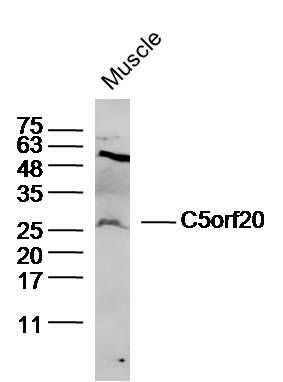C5orf20 Polyclonal Antibody
Purified Rabbit Polyclonal Antibody (Pab)
- SPECIFICATION
- CITATIONS
- PROTOCOLS
- BACKGROUND

Application
| WB, IHC-P, IHC-F, IF, ICC, E |
|---|---|
| Primary Accession | Q8TF63 |
| Host | Rabbit |
| Clonality | Polyclonal |
| Calculated MW | 27 KDa |
| Physical State | Liquid |
| Immunogen | KLH conjugated synthetic peptide derived from human C5orf20 |
| Epitope Specificity | 131-244/244 |
| Isotype | IgG |
| Purity | affinity purified by Protein A |
| Buffer | 0.01M TBS (pH7.4) with 1% BSA, 0.02% Proclin300 and 50% Glycerol. |
| SUBCELLULAR LOCATION | Nucleus. Note=Particularly on the periphery. |
| Important Note | This product as supplied is intended for research use only, not for use in human, therapeutic or diagnostic applications. |
| Background Descriptions | C5orf20 is a intronless gene is specifically expressed in dendritic cells (DCs), which are potent antigen-presenting cells involved in activating naive T cells to initiate antigen-specific immune response. The encoded protein is localized mainly in the perinucleus. One of the alleles (A/T) of this gene, that causes premature translation termination at aa 117, has been associated with an increased prevalence of major depression in humans |
| Gene ID | 140947 |
|---|---|
| Other Names | Dendritic cell nuclear protein 1, Dendritic cell nuclear protein-1, Dendritic cell-associated nuclear protein, DCANP1 (HGNC:24459) |
| Target/Specificity | Predominantly expressed in dendritic cells. Detected in brain and skeletal muscle. Highly expressed in mature dendritic cells and at a lower level in immature dendritic cells. Not expressed in monocytes and B-cells. |
| Dilution | WB=1:500-2000,IHC-P=1:100-500,IHC-F=1:100-500,ICC=1:100-500,IF=1:100-500,ELISA=1:5000-10000 |
| Format | 0.01M TBS(pH7.4), 0.09% (W/V) sodium azide and 50% Glyce |
| Storage | Store at -20 ℃ for one year. Avoid repeated freeze/thaw cycles. When reconstituted in sterile pH 7.4 0.01M PBS or diluent of antibody the antibody is stable for at least two weeks at 2-4 ℃. |
| Name | DCANP1 (HGNC:24459) |
|---|---|
| Function | Binds with and transactivates the corticotropin-releasing hormone (CRH) promoter. |
| Cellular Location | Nucleus. Cytoplasm Note=Particularly on the periphery. Colocalizes with corticotropin- releasing hormone (CRH) in parvocellular neurons in the paraventricular nucleus. |
| Tissue Location | Expressed in neurons of the paraventricular nucleus, thalamus and occipital cortex and in glial cells (at protein level). Predominantly expressed in dendritic cells. Detected in brain and skeletal muscle. Highly expressed in mature dendritic cells and at a lower level in immature dendritic cells. Expressed in paraventricular nucleus, supraoptic nucleus and nucleus basalis of Meynert. Strongly expressed in paraventricular nucleus of depressed patients compared to controls. Not expressed in monocytes and B-cells |

Thousands of laboratories across the world have published research that depended on the performance of antibodies from Abcepta to advance their research. Check out links to articles that cite our products in major peer-reviewed journals, organized by research category.
info@abcepta.com, and receive a free "I Love Antibodies" mug.
Provided below are standard protocols that you may find useful for product applications.
If you have used an Abcepta product and would like to share how it has performed, please click on the "Submit Review" button and provide the requested information. Our staff will examine and post your review and contact you if needed.
If you have any additional inquiries please email technical services at tech@abcepta.com.













 Foundational characteristics of cancer include proliferation, angiogenesis, migration, evasion of apoptosis, and cellular immortality. Find key markers for these cellular processes and antibodies to detect them.
Foundational characteristics of cancer include proliferation, angiogenesis, migration, evasion of apoptosis, and cellular immortality. Find key markers for these cellular processes and antibodies to detect them. The SUMOplot™ Analysis Program predicts and scores sumoylation sites in your protein. SUMOylation is a post-translational modification involved in various cellular processes, such as nuclear-cytosolic transport, transcriptional regulation, apoptosis, protein stability, response to stress, and progression through the cell cycle.
The SUMOplot™ Analysis Program predicts and scores sumoylation sites in your protein. SUMOylation is a post-translational modification involved in various cellular processes, such as nuclear-cytosolic transport, transcriptional regulation, apoptosis, protein stability, response to stress, and progression through the cell cycle. The Autophagy Receptor Motif Plotter predicts and scores autophagy receptor binding sites in your protein. Identifying proteins connected to this pathway is critical to understanding the role of autophagy in physiological as well as pathological processes such as development, differentiation, neurodegenerative diseases, stress, infection, and cancer.
The Autophagy Receptor Motif Plotter predicts and scores autophagy receptor binding sites in your protein. Identifying proteins connected to this pathway is critical to understanding the role of autophagy in physiological as well as pathological processes such as development, differentiation, neurodegenerative diseases, stress, infection, and cancer.


